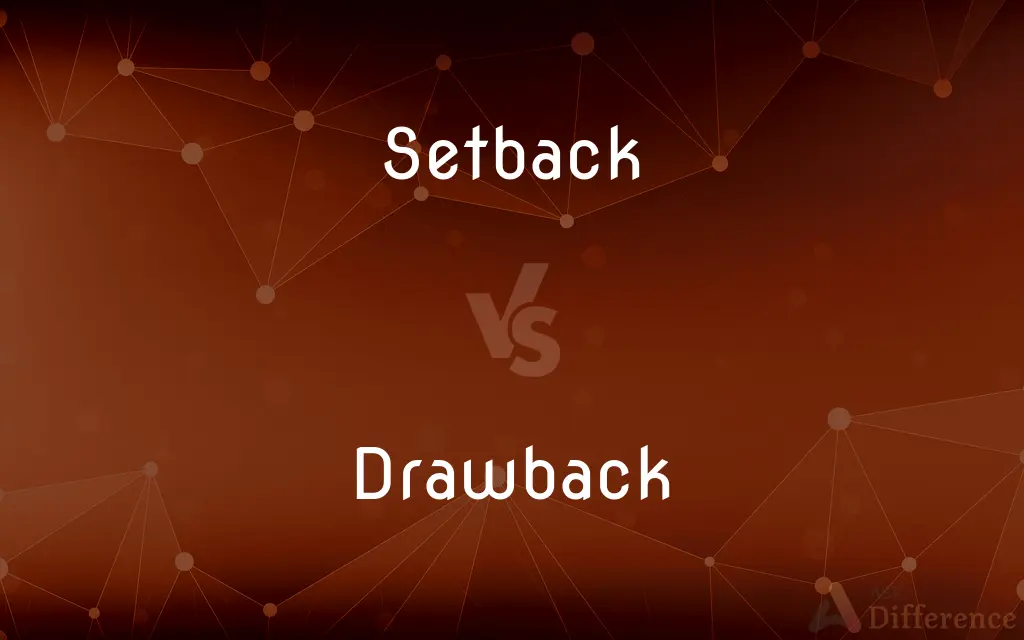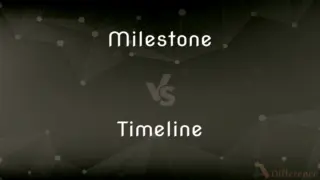Setback vs. Drawback — What's the Difference?
By Tayyaba Rehman & Maham Liaqat — Updated on March 15, 2024
A setback is a temporary obstacle that delays progress, while a drawback is a disadvantage or flaw in a situation or plan.

Difference Between Setback and Drawback
Table of Contents
ADVERTISEMENT
Key Differences
A setback often refers to an unexpected event or obstacle that temporarily hinders one’s progress toward a goal. For example, a project may face a setback due to unforeseen technical difficulties. On the other hand, a drawback is generally considered a persistent disadvantage or negative aspect associated with a situation, decision, or object, such as the high cost being a drawback of a new technology.
Setbacks are typically situational and can be overcome with time and effort, suggesting a temporary challenge. For instance, a setback in a research project might delay its completion date. Whereas, drawbacks are inherent qualities or conditions that detract from the overall value or feasibility of something, like the drawback of an investment being its risk.
In dealing with setbacks, the focus is often on recovery and finding solutions to move past the temporary hurdle. This implies a dynamic process of adjustment and problem-solving. Conversely, addressing a drawback may require accepting the inherent negative aspects or finding ways to mitigate its effects, indicating a more static and enduring issue.
Setbacks can motivate individuals or teams to develop resilience and adaptability, highlighting a capacity for growth and learning in the face of challenges. Drawbacks, however, prompt a need for careful consideration and evaluation, weighing the negative aspects against the potential benefits.
The perception of what constitutes a setback versus a drawback can vary depending on individual goals, values, and contexts. A financial loss might be seen as a setback by an established business but a significant drawback for a startup with limited resources.
ADVERTISEMENT
Comparison Chart
Definition
A temporary obstacle or delay in progress.
An inherent disadvantage or negative aspect.
Nature
Situational and temporary.
Persistent and inherent.
Focus
Overcoming and moving past the obstacle.
Mitigating or accepting the negative aspects.
Implications
Can lead to growth and learning.
Requires evaluation and careful consideration.
Examples
Delay in project completion due to technical issues.
High cost as a negative aspect of new technology.
Compare with Definitions
Setback
A temporary decline in health or well-being.
Her recovery from surgery experienced a setback due to complications.
Drawback
A disadvantage or unfavorable condition.
A major drawback of living in the city is the noise.
Setback
An interruption in progress or development.
The construction project faced a setback when the materials were delivered late.
Drawback
A condition that requires compromise or trade-off.
The job’s high pay comes with the drawback of extensive travel.
Setback
A delay in a scheduled event or timeline.
Bad weather caused a setback in the launch date.
Drawback
A negative feature that reduces effectiveness or appeal.
The phone’s short battery life is a significant drawback.
Setback
A reversal or defeat in a match or competition.
The team’s loss was a minor setback in their championship aspirations.
Drawback
An aspect that diminishes value or satisfaction.
Limited customization options are a drawback of the software.
Setback
A hindrance to personal goals or plans.
Failing the final exam was a significant setback in his academic career.
Drawback
A hindrance or deterrent to making a decision.
The high investment cost was a drawback for potential buyers.
Setback
An unanticipated or sudden check in progress; a change from better to worse.
Drawback
Drawback, also known as duty drawback is the refund of duties, certain taxes, and certain fees collected upon the importation of merchandise into the United States. Refunds are only allowed upon the export/destruction of the imported merchandise or a valid substitute, or the export/destruction of a certain article manufactured from the imported merchandise or a valid substitute.
Setback
A steplike recession in a wall. Also called setoff.
Drawback
A disadvantage or inconvenience.
Setback
Any of a series of such recessions in the rise of a tall building.
Drawback
A refund or remittance, such as a discount on duties or taxes for goods destined for reexport.
Setback
An automatically timed setting of a thermostat to a lower temperature, as in the home at night.
Drawback
A disadvantage; something that detracts or takes away.
Poor fuel economy is a common drawback among larger vehicles.
Setback
An obstacle, delay, disadvantage, blow an adverse event which retards or prevents progress towards a desired outcome
After some initial setbacks, the expedition went safely on its way.
Drawback
A partial refund of an import fee, as when goods are re-exported from the country that collected the fee.
Setback
(US) The required distance between a structure and a road.
Drawback
The inhalation of a lungful of smoke from a cigarette.
Setback
(architecture) A step-like recession in a wall.
Setbacks were initially used for structural reasons, but now are often mandated by land use codes.
Drawback
A loss of advantage, or deduction from profit, value, success, etc.; a discouragement or hindrance; objectionable feature.
The avarice of Henry VII . . . . must be deemed a drawback from the wisdom ascribed to him.
Setback
An offset to the temperature setting of a thermostat to cover a period when more or less heating is required than usual.
Drawback
Money paid back or remitted; especially, a certain amount of duties or customs, sometimes the whole, and sometimes only a part, remitted or paid back by the government, on the exportation of the commodities on which they were levied.
Setback
A backset; a countercurrent; an eddy.
Drawback
The quality of being a hindrance;
He pointed out all the drawbacks to my plan
Setback
(archaic) A backset; a check; a repulse; a relapse.
Setback
A backset; a countercurrent; an eddy.
Setback
A reversal of progress in an endeavor; a reverse; a backset; a check; a repulse; a relapse.
Setback
An unfortunate happening that hinders of impedes; something that is thwarting or frustrating
Common Curiosities
What is a setback?
A setback is a temporary challenge or obstacle that delays progress toward a goal.
What is a drawback?
A drawback is an inherent disadvantage or negative aspect associated with a particular situation, decision, or object.
Can a drawback have positive aspects?
While drawbacks are negative, recognizing them can lead to informed decision-making and potentially finding positive solutions or alternatives.
Can a setback become a drawback?
While a setback is generally temporary, if it leads to a long-term disadvantage, it might be perceived as a drawback.
Is a financial loss a setback or a drawback?
It depends on the context; it can be a setback if it's a temporary hurdle or a drawback if it indicates a deeper, inherent issue.
How can one overcome a setback?
Overcoming a setback typically involves problem-solving, adaptability, and perseverance to move past the temporary obstacle.
Do setbacks and drawbacks affect businesses and individuals differently?
Yes, the impact and perception of setbacks and drawbacks can vary greatly between businesses and individuals, depending on their resources, goals, and resilience.
Are drawbacks always negative?
Yes, drawbacks are considered negative as they denote disadvantages or aspects that reduce appeal or effectiveness.
Can drawbacks be mitigated?
Yes, through careful planning and consideration, the effects of drawbacks can often be minimized.
How should one approach drawbacks in planning?
Identifying and understanding drawbacks early on is crucial for effective planning and decision-making.
How do setbacks and drawbacks influence decision-making?
They necessitate careful consideration and evaluation, potentially leading to more informed and resilient choices.
How do setbacks affect personal growth?
Setbacks can foster resilience, adaptability, and learning, contributing to personal growth and development.
Can a disadvantage ever be considered a setback?
Disadvantages are generally seen as drawbacks, but in some contexts, temporary disadvantages might be referred to as setbacks.
Can setbacks lead to opportunities?
Yes, overcoming setbacks can open up new paths and opportunities that were not previously considered.
Are all setbacks unavoidable?
Some setbacks are unforeseeable and unavoidable, but others can be anticipated and managed with proactive planning.
Share Your Discovery

Previous Comparison
Mom vs. Aunty
Next Comparison
Milestone vs. TimelineAuthor Spotlight
Written by
Tayyaba RehmanTayyaba Rehman is a distinguished writer, currently serving as a primary contributor to askdifference.com. As a researcher in semantics and etymology, Tayyaba's passion for the complexity of languages and their distinctions has found a perfect home on the platform. Tayyaba delves into the intricacies of language, distinguishing between commonly confused words and phrases, thereby providing clarity for readers worldwide.
Co-written by
Maham Liaqat













































